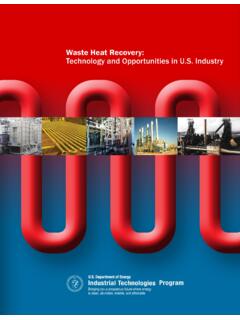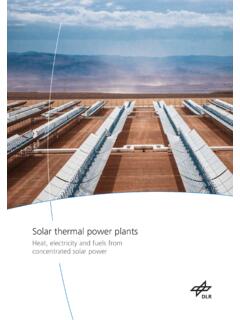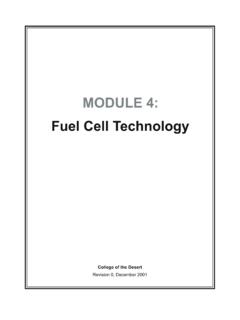Transcription of Active Thermal Control System (ATCS) Overview
1 IDS Business Support, Communications and Community Affairs Box 516 St. Louis, MO 63166 Active Thermal Control System (ATCS) Overview EEATCS ( )/EATCS ( +) Active Thermal Control System Architecture Most of the Station's many systems produce waste heat , which needs to be transferred from the ISS to space to achieve Thermal Control and maintain components at acceptable temperatures. An Active Thermal Control System (ATCS) is required to achieve this heat rejection function when the combination of the ISS external environment and the generated heat loads exceeds the capabilities of the Passive Thermal Control System to maintain temperatures.
2 An ATCS uses a mechanically pumped fluid in closed-loop circuits to perform three functions: heat collection, heat transportation, and heat rejection. Waste heat is removed in two ways, through cold plates and heat exchangers, both of which are cooled by a circulating ammonia loops on the outside of the station. The heated ammonia circulates through large radiators located on the exterior of the Space Station, releasing the heat by radiation to space that cools the ammonia as it flows through the radiators.. The ATCS consists of the Internal Active Thermal Control System (IATCS), External Active Thermal Control System (EATCS), the Photovoltaic Thermal Control System (PVTCS) and the Early External Active Thermal Control System (EEATCS).
3 The IATCS consists of loops that circulate water through the interior of the Destiny Laboratory module to collect the excess heat from electronic and experiment equipment and distributes this heat to the Interface heat Exchangers for transfer to the EATCS. At assembly complete, there will be nine separate ITCS water loops in the and International Partner pressurized modules. The Photovoltaic Thermal Control System (PVTCS) consists of ammonia loops that collect excess heat from the Electrical power System (EPS) components in the Integrated Equipment Assembly (IEA) on P4 and eventually S4 and transport this heat to the PV radiators (located on P4, P6, S4 and S6) where it is rejected to space.
4 The PVTCS consist of ammonia coolant, eleven coldplates, two Pump Flow Control Subassemblies (PFCS) and one Photovoltaic Radiator (PVR). 1 2 The External Active Thermal Control System (EATCS), activated for the first time on this mission, consists of ammonia loops to collect heat from the Interface heat Exchangers and external electronic equipment mounted on coldplates and transports it to the S1 and P1 radiators where it is rejected to space. In lieu of using the EATCS initially, the station hardware has been cooled by the Early External Active Thermal Control System (EEATCS). The EEATCS has provided heat rejection capability rejection capability for the Laboratory Interface heat Exchangers(IFHX) since assembly flight 5A through The EEATCS is the temporary System used to collect, transport, and reject waste heat from habitable volumes on the International Space Station (ISS).
5 The EEATCS collects heat from the Interface heat Exchangers (IFHX) located on the Laboratory module, circulates the working fluid, anhydrous ammonia, via the Pump and Flow Control Subassembly (PFCS), and rejects heat to space via two orthogonally oriented stationary radiators. Internal Active Thermal Control System (IATCS) The purpose of the Destiny Laboratory ITCS is to maintain equipment within an allowable temperature range by collecting, transporting, and rejecting waste heat . The ITCS uses water because it is an efficient Thermal transport fluid and is safe inside a habitable module. The IATCS is a closed loop System that provides a constant coolant supply to equipment, payloads and avionics to maintain proper temperature.
6 The Laboratory contains two independent loops, a Low Temperature Loop (LTL) and a Moderate Temperature Loop (MTL). This approach allows for segregation of the heat loads, simplifies heat load management, and provides redundancy in case of equipment failure. The LTL is designed to operate at 40 F (4 C) and service systems equipment requiring low temperatures, such as the Environmental Control and Life Support System (ECLSS) Common Cabin Air Assembly (CCAA) and some payload experiments. The LTL contains approximately gallons (63 liters) of fluid. The MTL nominally operates at 63 F (17 C) and provides most of the cooling for systems equipment ( avionics) and payload experiments.
7 The MTL contains approximately gallons (200 liters) of fluid. The IATCS loops can be configured and operated as a single loop. This capability is used for a variety of purposes, including the reduction of wear on the pumps, reduction of pump power usage, or to compensate for a pump failure. Photovoltaic Thermal Control System (PVTCS) The PVTCS consist of ammonia coolant, eleven coldplates, two Pump Flow Control Subassemblies (PFCS) and one Photovoltaic Radiator (PVR). The coldplate subassemblies are an integral part of IEA structural framework. heat is transferred from the IEA orbital replacement unit (ORU) electronic boxes to the coldplates via fine interweaving fins located on both the coldplate and the electronic boxes.
8 The fins add lateral structural stiffness to the coldplates in addition to increasing the available heat transfer area. The PFCS is the heart of the Thermal System . It consists of all the pumping capacity, valves and controls required to pump the heat transfer fluid to the heat exchanges and radiator, and regulate the temperature of the Thermal Control System ammonia coolant. The PVTCS can dissipate 6,000 Watts of heat per orbit on average and is commanded by the IEA computer. Each PFCS consumes 275 Watts during 3normal operations and measures approximately 40 inches ( cm) by 29 inches ( cm) by 19 inches ( cm), weighing 235 pounds ( kilograms).
9 The PVR the radiator is deployable on orbit and comprised of two separate flow paths through seven panels. Each flow path is independent and is connected to one of the two PFCSs on the IEA. In total, the PVR can reject up to 14 kW of heat into deep space. The PVR weighs 1,633 pounds ( kilograms) and when deployed measures feet ( meters) by feet ( meters). When the ISS assembly is complete, there will be a total of four PVRs, one for each PV module (S4, P4, P6, S6). Early External Active Thermal Control System (EEATCS) Function Since the Laboratory became operational before the permanent External Active Thermal Control System (EATCS) was assembled, a temporary external cooling System was needed.
10 External cooling from the Russian segment is not possible because there are no operational interfaces between the On-orbit Segment (USOS) and the Russian On-orbit Segment (ROS) Thermal systems. Instead, a modified version of the Photovoltaic Thermal Control System (PVTCS) called the Early External Active Thermal Control System (EEATCS) acts as a temporary Thermal System . The EEATCS consists of two independent, simultaneously operating ammonia cooling loops (ACL). These loops transport heat loads from the Interface heat Exchanger (IFHX) located on the Laboratory module's aft endcone to the radiators located on truss segment P6. The EEATCS is needed until the permanent EATCS is activated.

















